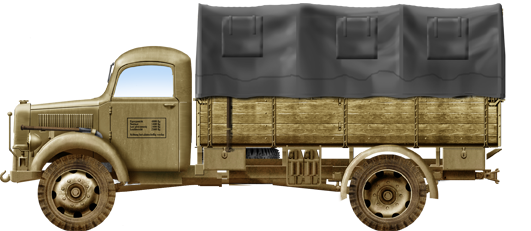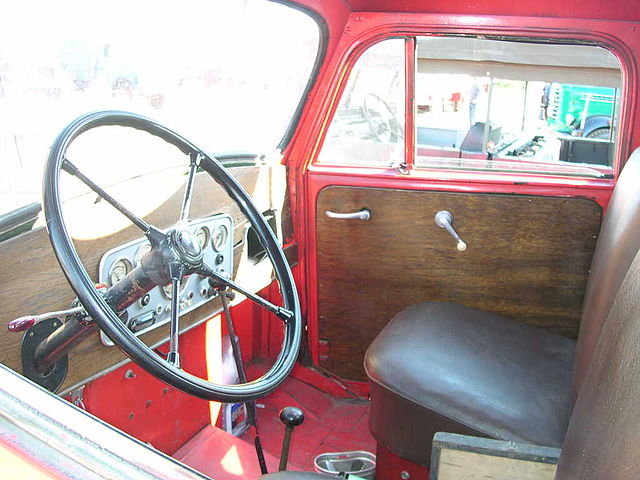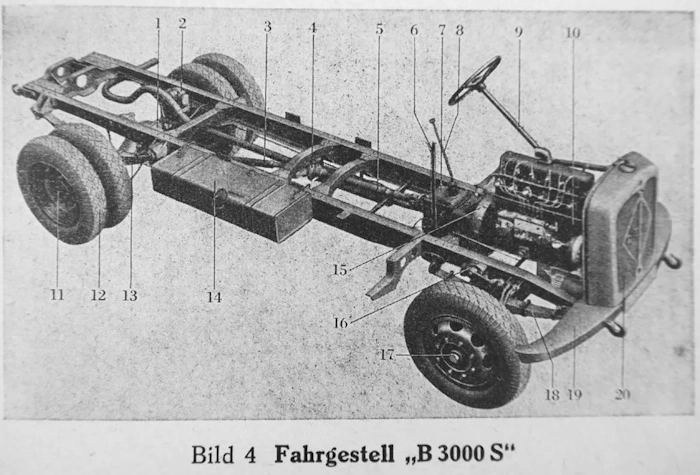Borgward B 3000 (1938)
 Germany (1934-45) - Medium Truck - 30,000 built
Germany (1934-45) - Medium Truck - 30,000 built
The Borgward B 3000 was a medium-sized truck made by Carl F. W. Borgward GmbH between 1941 and 1944 at its Bremen-Sebaldsbrück plant. After World War II, production resumed from July 1948 to 1950 and an electric version BE3000 was als manufactured under British occupation forces supervision. Th B 3000 was also called Einheits-Lkw 3 t, and standardized as a 5-ton payload model under supervision of the ministry of transport for the needs of the army branch, the same standard giving the Opel Blitz and Mercedes L3000. No less than 30,000 B3000 were made either diesels or gasoline engines, taking part in the German army logistical train from Europe to Africa on all fronts. It was however judged inferior to the Blitz and was never declined into an half-track.

Design development 1934-38
About Borgward
Borgward is a former Bremen-based German automobile manufacturer established in 1933 by Carl F. W. Borgward (1890–1963) and which he led until its controversial bankruptcy in 1961. It was arguably the last significant German personal automobile manufacturing company. But the company also soon produced trucks and buses, including for the rising Werhmacht in the process of mass motorization. Thus, Borgward started building trucks in 1937, and proposed a range up to five tons payload before the Second World War such as the 3-ton Borgward G. W. truck with sub-variants in petrol or Diesel engines.
The Schell Plan forced Borgward to change its product range in 1939/1940, standardize radically its offer. In the mid-1930s, the company had a test site west of Bierden to develop and test of off-road vehicles and from 1938 it was relocated between the two production sites of Hastedt and Sebaldsbrück. During the Second World War, Bordgward beame a major supplier for half-tracks such as the Sd.Kf.11 and even armored personnel carriers, tractors and load carriers. During the war, the test site was used by the Luftwaffe which placed on it AA batteries to defend Bremen. Torpedoes were also produced by Borgward. The Bremen-Sebaldsbrück plant opened in 1938 but was 58% destroyed in the raid on Bremen on October 12, 1944. The Goliath plant in Hastedt was 87% destroyed. This put an end to any production by the company.
Borgward produced also the Sd.Kfz. 7 half-track, Sd.Kfz. 251 armoured half-track and Borgward IV tracked carrier. This was in addition to some 30,000 standard 3-ton trucks built until the plants were razed by Allied bombing in 1944. Plans to build the Opel Blitz in a new Bremen hidden plant failed as British troops discovered it still in completion in May 1945.
To protect against Allied air raids, the Ottersberg plant was also built in 1943/1944 by the Todt Organization in the Nadah forest mostly by POWs and forced labor. It was made of six concrete/wooden halls, to produce Gearbox and axle, relocated to Delmenhorst. The SS maintained athe satellite camp of Neuengamme and Bremen-Sebaldsbrück (Borgward) concentration camp until the raids of October 1944, and all this later was opposed by the allies to the former Borgward staff. It seems to have resume production until capture by British troops also in May 1945.
The Borgward B 3000
As a successor model to the "standard truck", the 3-ton truck B 3000 S/O appeared as a candidate for mass production, powered by a 3.7-liter petrol engine rated for 78 hp, and the alternative Borgward B 3000 S/D powered by a 5-liter diesel engine rated for 75 hp. Both were six-cylinder which emerged from Bordgawrd factories from 1942. The all-wheel drive was given the designation "A". Later, savings in materials led to a much simplified design, notably seeing the elimination of the trademark radiator grille diamond and with the installation of a standard slab-sided wooden driver's cab instead of the steel sheet cabin.
Production: c30,000 built

A large contingent of 1939 civilan-grade B 3000 trucks were requisitioned by the Wehrmacht. Initially, production of the regular truck range continued but in 1940, and order was given to all German truck manufacturers to curtail their offer and focus on the production of simplified standard "3 tons" trucks based on their average payload. In reality it went up to five tons in action.
As of 1942, production of the successor "Einheits-LKW" universal standard truck rated at 3-ton was designated Borgward B 3000 S/O (78 hp petrol engine) B 3000 S/D (75 hp diesel) while mass simplification brought wooden cabins and many ommissions. The new simplified cabin was caled the "Einheitsführerhaus". The B 3000 was reported on the front to be "adequate" but the lighter Opel Blitz V 3000 proved superior.
Design



This Borgward model 1943 had a conventional four-wheel drive but previous iterations from 1940 had classic rear drive. In all cases, the forward axle was the driving one, the rear axles had double tires, and was fixed. The chassis was of classic ladder-type as seen above. The cabin had standard rounded shapes that were difficult to produce and elminated as the war went on, as the serie culminated woth the Borgward B 3000 A, manufactured in small numbers from 1942 to 1943.
Variants
- Borgward B3000O
1938-1941, 3-ton 4x2, 6-cyl. petrol 3485cc 65hp, 38k b/w photo, this is soft top einheits cab truck
- Borgward B3000D
1939-1943, 3-ton 4x2, 6-cyl. diesel 4426cc 64hp
- Borgward B3000S/O
1942-1944, 3,125-ton 4x2, 6-cyl. petrol 3745cc 78hp
- Borgward B3000A/O
1942-1943, 3,095-ton 4x4, 6-cyl. petrol 3745cc 78hp
- Borgward B3000S/D
1942-1943, 3-ton 4x2, 6-cyl. diesel 4962cc 75hp, 75k b/w photo of closed cab truck
- Borgward B3000A/D
1942-1943, 3-ton 4x4, 6-cyl. diesel 4962cc 75hp, 29k b/w photo of closed cab truck
- Sd.Kfz.11
(Borgward HL kl) 6Half track variant covered here. 6-cyl. gasoline 100hp.
The Borgward B3000 in combat
 B3000 in Russia, winter 1943-44, recaptured by Russian troops.
B3000 in Russia, winter 1943-44, recaptured by Russian troops.
The first model pressed into combat was a civilian model with a coat of paint, generally called "3-Tonner resp. Typ 3t Diesel G.W." by the Wehrmacht, construction year 1938, retaining features of the Hansa-Lloyd Dreitonner. The Borgward emblem on the radiator water sported "diesel" or "benzin". The Typ 3t Diesel G.W. and its torquy 64 HP engine generally had the regular all metal production-line driver's cab and performed well according to reports, throught Poland, France and the Balkan campaigns. In Russian this was another story.
The Borgward 3-Tonner resp. Typ 3t Benzin G.W. as called by th Wehrmacht existed in standard steel cab and by 1941 a simplified wooden cab with tarpaulin or open standard driver’s cab called Einheitsführerhaus. They were also fitted with a great variety of box bodies at the rear, whoch benefited of the longer chassis of the Borgward Type 3t Benzin/Diesel G.W. delivered starting in 1940/41. Some had an Anhänger (1 achs.) für Sammlerladegerät D (Sd. Ah. 23) towed as Sammlerkraftwagen (Kfz. 42). Other served as Nachrichtenwerkstattkraftwagen (Kfz. 42) or ambulances.
The B 3000 S/O resp. B 3000 S/D was the successor of the type 3t Benzin G.W./Diesel G.W.and initially they had the typical Borgward rhombus on the radiator grille. It was also more powerful with a 78 HP petrol engine or 75 HP diesel and later the rhombus was omitted in late production whereas variantsb multiplied, ambulances, radio vehicles, specialized transport, tanker, recovery... They were also used by the Luftwaffe.
The B3000 was used in the Balkans Campaign in 1941 for its combat debut. During the retreat, many remained in southern Austria. Some were hidden on the property of farmers. After one of these died in 1986, his truck with only 10,700 km was brought back to light and sold at auctions. It was given a uniform coat of paint but remained absolutely original in every conceivable detail, albeit the now rotten wooden structure of the flatbed. In 1942 North Africa, these were earlier models of the S/O types and later in 1943 between there and Italy, the B 3000 A.
Borgward B 3000 A/O specs. |
| Dimensions | 6.9 x 2.4 x 3 m (21 ft 6 in x 7 ft 8 in x 9 ft 9 in) |
| Total weight, battle ready | 2,790 kg |
| Crew | 3 seats, 2 crew |
| Propulsion | 3500L petrol, 6 cyl. 4-stroke 75 HP |
| Top speed | 80 km/h |
| Payload | 3 tons nominal, 3,400 kg |
| Transmission | Rear axle, 4x4. Gearbox 4V/1R + reduction |
| Suspension | |
| Maximum range (on/off road) | c500 km |
| Armament | None |
| Armor | None |
| Production | 30,000 global |